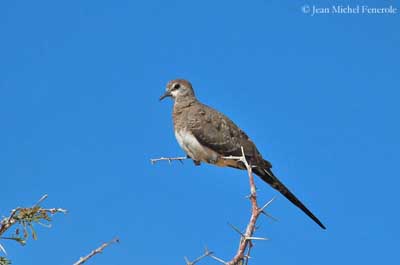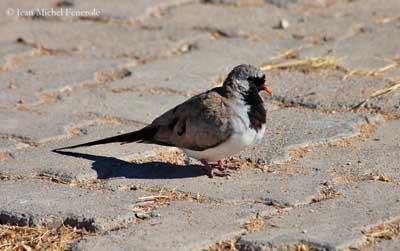
Fr: Tourterelle masquée
All : Kaptäubchen
Esp : Tortolita Rabilarga
Ital: Tortora maschera di ferro
Nd: Maskerduif
Sd: Långstjärtsduva
Photographers:
Didier Buysse
Vision d’Oiseaux
Jean Michel Fenerole
Photos d’Oiseaux du monde
Steve Garvie
RAINBIRDER Photo galleries
Paul Guillet
Photos d'Oiseaux
Callie de Wet
GALLERY
Text by Nicole Bouglouan
Sources:
HANDBOOK OF THE BIRDS OF THE WORLD vol 4 by Josep del Hoyo-Andrew Elliott-Jordi Sargatal - Lynx Edicions - ISBN: 8487334229
PIGEONS AND DOVES by David Gibbs, Eustace Barnes and John Cox - Pica Press Sussex - ISBN: 1873403607
BirdLife International (BirdLife International)
Wikipedia, the free encyclopaedia
Namaqua Dove
Oena capensis
Columbiforme Order – Columbidae Family
BIOMETRICS:
Length: 28 cm (with the tail)
Wingspan: 28-33 cm
Weight: 28-54 g
DESCRIPTION:
The Namaqua Dove is the only species of the genus Oena. This tiny elegant dove has very long and graduated tail and conspicuous black mask in male.

The adult male has black face, chin, throat and front of the breast, bordered greyish-white. The rest of the head, neck and breast sides, and most of the wing-coverts are pale bluish-grey. The hind neck, mantle and scapulars are pale fawn to brown.
The upperwing shows 4-5 iridescent, purple to dark blue spots. The primaries are chestnut and black-tipped, with edged black outer webs.
Back and rump are brownish. The lower back shows two black bands separated by another whitish band.
The uppertail-coverts are greyish to brownish-grey, and black-tipped, forming a narrow black bar. The central rectrices are grey and broadly black-tipped. The outer tail feathers are blue-grey and the outermost pair shows white outer webs. The tail is graduated and long.

On the underparts, outside the black face and bib, lower breast and belly are white. The underwing is chestnut and black. The primary coverts and the flight feathers are chestnut and tipped black. The inner wing is black or dark grey. The undertail is black.
The bill has reddish base and yellow-orange tip. The eyes are dark brown with reddish-grey to grey eye-ring. Legs and feet are purple-red.
The female has brownish-grey plumage and she is duller than the male. She lacks the black mask and shows greyish-white face and greyish head. The lores are black. The bill is dark reddish.
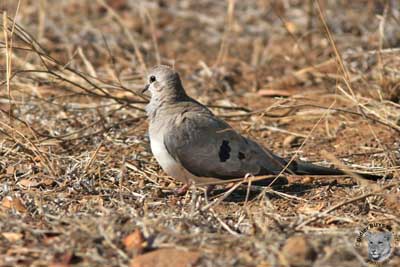
The juvenile has speckled appearance. Some young males show blackish breast feathers with pale tips.

The subspecies Oena capensis aliena from Madagascar is darker and greyer.
VOICE: SOUNDS BY XENO-CANTO
The Namaqua Dove male utters quiet, monotonous and low-pitched territorial song, starting with “hoo…hoo…” and ending in longer, slightly raising “woooo”.
During the displays, the male utters a “kuk’ wurrr” while it follows the female. We can also hear descending series of 6-12 notes “du du du du …”.
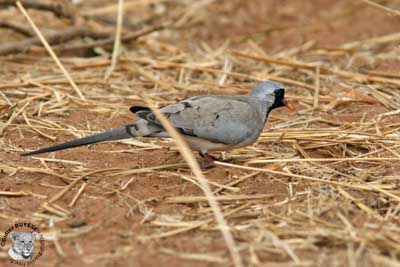
HABITAT:
The Namaqua Dove frequents Acacia savannas and thorny fields, mainly in open sandy areas. It avoids the forests, but can be seen in grasslands with bushes and also in cultivated areas.
This species is visible in tropical and subtropical lowlands up to 1600 metres of elevation, with some records up to 3000 metres in Kenya.
In Madagascar, it frequents the lowlands up to 1500 metres of elevation.
RANGE:
The Namaqua Dove is found in Sub-Saharan Africa and Madagascar. Its range extends into Arabian Peninsula S Israel, Jordan and N to Turkey.

BEHAVIOUR:
The Namaqua Dove is usually seen alone or in pairs, but they can gather in large flocks at abundant food sources and near water. It feeds mainly on seeds from grass and cereals. It rarely catches insects or snails. It forages on the ground and moves quickly across open areas with bare ground.

The Namaqua Dove is monogamous but weakly territorial. The advertising song is given by the male from its favourite perch, and the flight display is often performed from the same perch.
The male rises steeply and then, descends in slow glide on stiff wings and with the tail fanned. We can also see several males chasing a female with fast direct flight.
The displays performed on the ground are typical of Columbidae species. The male calls while lowering the head and raising the tail. It also pursues the female by running or with bounding flight, while uttering “kuh’ waaarrr’.

Some populations are sedentary, but seasonal movements occur in several areas, related to rainfall patterns.
The populations of Israel, Arabia and probably SE Egypt, are highly migratory and move southwards to winter.
The movements north and south of equator are very complex, and related to breeding and feeding.
FLIGHT:
The Namaqua Dove performs typical flight displays. When alarmed, it makes direct, fast, short flight with soft wing-beats. As all the doves, it flies very well.
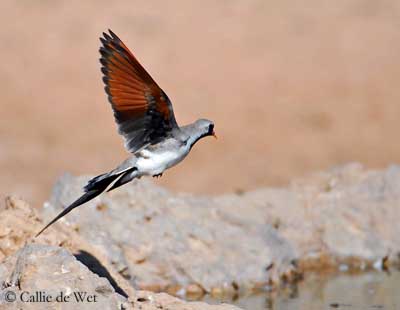
REPRODUCTION:
The Namaqua Dove breeds all year round in most parts of the range, but there are some variations according to the range and the rainfalls.
The nest is placed in low bushes, usually above the ground, between 2 and 5 metres, sometimes lower or even on the ground. Both sexes build the nest.
It is a small, flat, flimsy platform made with woven small twigs and rootlets, and the cup is lined with grass. The nest is often built in open area and poorly concealed.
The female lays two pale yellow to buff eggs. Both adults incubate during 13-16 days. The young birds are fed by their parents several times a day. They fledge at two weeks and become quickly independent. They are tolerated by the adults within the parental territory until they have the adult plumage.

DIET:
The Namaqua Dove feeds mainly on seeds from numerous grasses, including sedges. This bird takes occasionally insects and snails, but rarely. It forages on the ground.

PROTECTION / THREATS / STATUS:
The Namaqua Dove is common and widespread, sometimes locally abundant. The populations are increasing in Israel and Arabia.
The species is not currently endangered.
